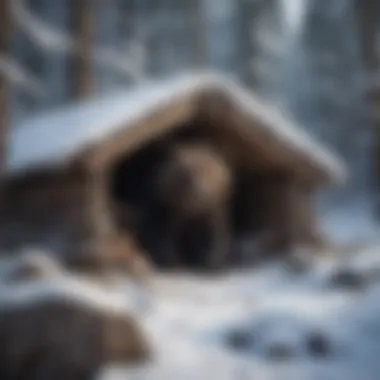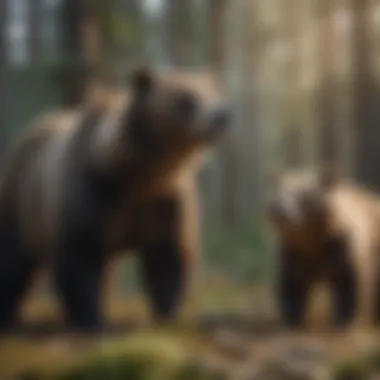Understanding Bear Hibernation: Facts and Science


Nature Topic Overview
Hibernation is an extraordinary survival strategy that some animals, particularly bears, use during harsh winter months. This natural process allows them to conserve energy and survive when food is scarce. It is crucial to understand the biological and ecological aspects of bear hibernation to appreciate its significance fully. Each bear species has unique adaptations that favor their environment, and this article explores these fascinating nuances. Hibernation is not merely a long sleep; it involves complex physiological changes that affect how bears regulate their body temperature, metabolism, and overall health.
Fun Facts and Trivia
Did you know that bear hibernation can last several months? Here are some interesting facts that may surprise you:
- Bears do not eat, drink, urinate, or defecate during hibernation.
- A bear's heart rate can drop from around 40 beats per minute to as low as 8.
- The temperature of a hibernating bear can drop only slightly, compared to other hibernators.
- Pregnant bears give birth during hibernation, often to twins.
Visuals and Interactive Elements
Consider exploring interactive websites or children’s books that illustrate bear hibernation in action. These resources can enhance learning for young readers, helping them visualize the unique lifestyle of bears during the winter months.
Wildlife Explorations
When we talk about bears, several species come to mind, including the American Black Bear, Grizzly Bear, and Polar Bear. Each species has its own unique hibernation patterns:
- American Black Bear: Typically hibernates for 5 to 7 months, depending on the climate and food availability.
- Grizzly Bear: Often enters a state of hibernation later in the fall and can weigh up to 30% less by spring.
- Polar Bear: Unlike other bears, pregnant female polar bears will enter a den to give birth and hibernate until spring.
Understanding these species helps us comprehend how each adapts to its specific habitat, which is vital for their survival.
Interactive Features
Encourage kids to explore through quizzes about bear habitats or puzzles about their sleeping behaviors. This interactive learning can make the information more engaging and memorable.
Environmental Awareness
The topic of bear hibernation opens up discussions about conservation and maintaining ecosystems. Bears play a significant role in their habitats, impacting the forest ecology. Their hibernation patterns affect not only their survival but also the life cycles of various plants and animals.
Conservation Tips
Children can play a role in protecting bear populations and their habitats by:
- Learning about local wildlife and participating in nature walks.
- Discussing the importance of not littering in natural spaces.
- Joining local conservation groups or participating in educational workshops.
DIY Nature Activities
Engaging in nature-inspired activities can solidify learning. Here are some fun and simple projects to try at home:
Hands-On Activities
- Bear Den Craft: Use cardboard boxes and paint to create a bear den. Discuss what a bear might need inside.
- Hibernate Like a Bear: Organize a sleepover where participants mimic bear behaviors, including finding a cozy place to ‘hibernate’.
- Outdoor Explorations: Take a nature hike and look for signs of wildlife preparing for winter.
These activities provide practical applications of what has been learned about bear hibernation, fostering a deeper connection to nature.
Bear hibernation is a vital part of their life cycle, impacting ecosystem health. Understanding it is essential for conservation efforts.
Prologue to Bear Hibernation
Hibernation is a fascinating survival strategy that many animals, including bears, use to cope with harsh environmental conditions. For bears, this remarkable process plays a crucial role in their life cycle, helping them endure periods of food scarcity and extreme cold. Understanding bear hibernation allows us to appreciate the complex physiological changes and behaviors these animals exhibit.
The significance of studying bear hibernation goes beyond mere curiosity. It sheds light on the ecological importance of bears and their habitats. Knowledge about hibernation can also inform conservation efforts, as it reveals how environmental changes can impact bear populations.
In this article, we will explore several key elements about hibernation:
- The biological processes involved.
- The different species of bears that Hibernate.
- Geographic distribution and how it affects their hibernation patterns.
- The influence of environmental factors on their hibernation cycle.
This knowledge is not just of academic interest; it has real-world applications. For instance, understanding how climate change affects bear hibernation can help guide conservation strategies. As we delve into these topics, we aim to provide a clear and engaging narrative suitable for children, parents, teachers, and caregivers. Through this exploration, we hope to foster a deeper appreciation for bears and their place in the ecosystem.
What is Hibernation?


Hibernation is an extraordinary natural phenomenon that intrigues scientists and nature enthusiasts alike. It plays a crucial role in the survival of certain animal species, including bears. Understanding what hibernation is helps us appreciate how these animals adapt to their environments. This article will elucidate key elements surrounding hibernation, the underlying benefits for bears, and considerations necessary for recognizing its importance in ecological systems.
Defining Hibernation
Hibernation refers to a state of prolonged dormancy that some animals enter to survive adverse environmental conditions, particularly during the winter months. During hibernation, an animal's metabolic rate slows significantly. This leads to a drastic reduction in body temperature, heart rate, and overall energy consumption.
The definition of hibernation is nuanced. Not all dormancy periods are hibernation. True hibernation, or deep sleep, happens for an extended time, often months. This differs from winter sleep, where animals may wake more often. For many species, like bears, hibernation is essential for survival when food is scarce and temperatures are freezing.
Difference Between Sleep and Hibernation
Sleep and hibernation may seem similar, but they have distinct differences. Sleep is a temporary state of rest. Every day, animals sleep to recharge, but they remain somewhat alert and can easily awaken in response to external stimuli. In contrast, hibernation involves a significant drop in alertness and is a deeper, prolonged state of dormancy.
Key Differences:
- Duration: Sleep lasts for hours; hibernation can last for months.
- Physiological Changes: Hibernators experience significant physiological changes, including reduced heart rate and lowered body temperature. Sleepers do not undergo such drastic changes.
- Awareness: Animals that sleep remain aware of their surroundings; hibernators enter a state where they are less responsive to stimuli.
"Understanding the concept of hibernation helps us appreciate the remarkable adaptations in the animal kingdom."
In sum, distinguishing between sleep and hibernation is essential to grasp how certain species, especially bears, utilize this natural strategy to survive harsh conditions. Recognizing these differences sets the stage for understanding hibernation patterns in different bear species and its ecological implications.
Biology of Hibernation
The biology of hibernation reveals how bears survive harsh winters. This section focuses on physiological and behavioral adaptations that allow bears to hibernate effectively. Understanding these elements is crucial for grasping bear ecology and the impact of their hibernation on ecosystems.
Physiological Changes During Hibernation
Hibernation is a remarkable state wherein a bear undergoes significant physiological transformations. During this period, a bear's heart rate can drop from a normal 40-50 beats per minute to as low as 8-10 beats. This drastic change helps conserve energy. The bear's body temperature also decreases, which further reduces metabolic demand. This state of reduced activity is essential because it allows bears to survive for months without eating or drinking.
These changes are not random; they are well-timed and enable bears to utilize stored fat effectively. When a bear enters hibernation, it relies on fat reserves accumulated during warmer months. The body's metabolism shifts to extract energy primarily from fat, rather than glucose. This unique adaptation is crucial for survival, given the scarcity of food during winter. Additionally, bears do not experience muscle atrophy, which is often seen in other hibernating animals, making their recovery after hibernation swifter.
Energy Conservation Strategies
Energy conservation is critical during the hibernation period. As bears prepare for hibernation, they increase their food intake in the fall, often consuming high-calorie foods like berries and nuts. This behavior is referred to as hyperphagia, where bears can gain up to 30 percent of their body weight before entering hibernation.
Once in hibernation, bears employ several strategies to manage energy use:
- Lowered Metabolic Rate: The slowed down metabolism aids energy conservation.
- Reduced Movement: Bears remain in a dormant state, limiting movement to conserve energy.
- Fat Utilization: Bears primarily depend on their fat stores, reducing dependence on other energy sources.
These strategies ensure that bears can successfully sustain themselves through the winter months. They awaken in spring with adequate energy to forage and breed, essential for their life cycle. Understanding these energy conservation techniques helps illustrate the delicate balance of bear ecology and the importance of preserving their habitats.
Bears: The Hibernators
Bears hold a vital position in the ecosystem, and understanding their hibernation is crucial for appreciating their role. Hibernation is not just a survival strategy. It is a complex behavior that affects their health, reproduction, and interaction with the environment. By studying bears, we gain insight into broader ecological patterns and the impacts of climate change on wildlife.
Species of Bears that Hibernate
Multiple species of bears exhibit hibernation behavior, each with unique adaptations:
- American Black Bear: This species is widespread and is known for its semi-hibernation, where it may awaken during warm spells.
- Grizzly Bears: They enter a deep hibernation and rely on fat reserves, often going without food or water for months.
- Polar Bears: Interestingly, pregnant females hibernate, while males and non-pregnant females do not. They create dens for this purpose.
Each species has developed specific traits to optimize their survival during hibernation. Understanding these differences enhances our knowledge of their ecology and conservation needs.
Geographic Distribution of Hibernating Bears
The distribution of hibernating bears is influenced by climate and habitat:
- North America: The American black bear and grizzly bear are found across various regions, from forests to mountains.
- Asia: The Asiatic black bear is often seen hibernating in the higher elevation areas of mountainous regions.
- Arctic Regions: Polar bears inhabit the Arctic but have specific dens in the ice where females hibernate.
These geographic variations underscore the relationship between bear species and their environments. Understanding where these bears live is important for planning effective conservation strategies.
"Learning about bears and their hibernation helps us protect these magnificent animals and their habitats for future generations."
The knowledge gained from studying hibernating bears can greatly inform conservation efforts, ensuring these species continue to thrive.


Hibernation Patterns in Different Species
Hibernation is crucial for the survival of bear species during challenging seasons. Understanding hibernation patterns can help us grasp how these animals cope with environmental fluctuations and resource scarcity. Each species has adapted unique strategies, affecting their behavior and habitat. The learning from these hibernation patterns is essential for conservation as it informs our actions in preserving their environments and mitigating the threats they face.
Black Bears and Their Hibernation Habits
Black bears exhibit clear hibernation patterns based on their geographical location. They typically enter hibernation around late November and leave, depending on weather conditions, from February to April. Unlike some other species, black bears can wake intermittently during hibernation, which allows them not just to conserve energy but also to respond to their surroundings.
During hibernation, black bears lower their heart rate significantly, sometimes dropping to as low as 8 beats per minute. They also experience a decrease in body temperature and metabolic rate, allowing them to survive on stored fat. One fascinating aspect of black bear hibernation is their ability to give birth while in this dormant state. Female black bears can give birth to cubs in their dens, showcasing how they merge reproductive behavior with hibernation.
Grizzly Bears and Hibernation Strategy
Grizzly bears have more extended hibernation patterns due to their need for more substantial energy reserves. Generally, they enter hibernation later in the fall, often around mid-November, and can stay dormant until March or April. Their hibernation lasts longer, as they need to accumulate more fat, especially since their habitat often experiences harsher winters than those of black bears.
This species tends to be more selective when preparing for hibernation. Grizzly bears are known to engage in 'hyperphagia,' where they consume large quantities of food in the months leading up to winter. They gain substantial weight, often exceeding 400 pounds before hibernating. Grizzlies also tend to be more sensitive to temperature changes, often awakening during warm spells in winter and then going back into hibernation again.
Polar Bears and Their Unique Approach
Polar bears take a different approach to hibernation, which is not strictly a hibernation process as seen in other bear species. Unlike the black bear and grizzly bear, polar bears do not hibernate in the same way. Pregnant females build dens to give birth, and they may enter a state of dormancy while nursing cubs, but active male and non-pregnant females are often active throughout the winter months.
Polar bears depend on sea ice as a platform for hunting seals. Their hibernation behavior mainly revolves around energy conservation during the breeding season or gestation. During this time, females seek shelter and rest to reduce energy expenditure. These adaptations to life in such extreme cold show how versatile the bear family can be.
Understanding the unique hibernation patterns of different bear species is essential for their conservation. Each strategy highlights the importance of habitat preservation.
This comparative analysis of bear hibernation reveals how species-specific strategies drive behavior in response to environmental challenges. It helps biologists assess how changes in climate and habitat can disrupt these essential survival practices.
Environmental Factors Influencing Hibernation
Understanding environmental factors is essential when examining bear hibernation. These factors help define the conditions under which bears enter hibernation and can influence their survival. For bears, hibernation is not only a way to conserve energy but also a reaction to environmental changes.
By recognizing how elements like temperature and food availability impact hibernation, we can gain insight into the lives of these animals. This awareness can inform conservation efforts aimed at protecting bear populations, especially as climate change threatens their habitats.
Temperature and Its Impact
Temperature plays a crucial role in hibernation. Bears are sensitive to fluctuations in temperature. As the weather cools down in autumn, bears begin to seek out suitable places for hibernation. The colder months trigger physiological changes in their bodies.
When it gets cold enough, a bear's metabolism slows down. This process helps reduce energy needs during periods of dormancy. If temperatures rise too much during winter, bears may not hibernate deeply or could wake up early. This can cause them to use up essential fat reserves, which are critical for their survival until the following spring.
Food Availability and Hibernation Timing
Food is another key element in the hibernation process. Bears need to gather sufficient fat before entering hibernation. This preparation usually happens in late summer and fall. Bears consume large quantities of food during this period, known as hyperphagia. They can eat up to 20,000 calories a day to build up fat reserves.
However, food availability is not always consistent. If there is a shortage of food due to environmental factors, bears may enter hibernation earlier or later than normal. This can affect their health when they wake.
The timing of hibernation is vital to ensuring that bears survive the winter. Understanding these food dynamics can help conservationists develop strategies to maintain healthy habitats for bear populations to thrive.
The Process of Hibernation
Understanding the process of hibernation is critical for appreciating how bears survive harsh winter conditions. Hibernation is not simply a long sleep; it is a complex biological process that supports various functions vital for a bear's survival. This section will explore the preparation bears undergo before hibernation and the details of the hibernation period itself. Key aspects include energy conservation, physiological changes, and behavioral adaptations that play a significant role in this process.
Preparation for Hibernation
Before entering hibernation, bears must prepare adequately. This preparation often starts months in advance. One of the most important steps is accumulating fat reserves. The animals engage in a behavior known as hyperphagia. During hyperphagia, bears eat significantly more food during the late summer and fall months. This ramp-up in feeding ensures they store enough energy for the long months of dormancy.
Additionally, bears search for a suitable location to hibernate. This site is usually a secluded den. The den's location needs to provide protection from the elements and predators. Bears look for caves, hollowed-out trees, or dug-out areas in the ground. They often line their dens with leaves, grass, and other vegetation to create a comfortable environment. This meticulous preparation can influence the overall health of the bear upon awakening and affects its chances for successful survival.
The Hibernation Period and Duration
Hibernation typically lasts several months, depending on the species and environmental conditions. During this period, bears undergo significant changes in their physiology. Their heart rate slows dramatically, sometimes dropping to as low as eight beats per minute as the bear enters a state of torpor. In this state, metabolic rates decrease, enabling bears to conserve energy while relying on their fat reserves.
The length of hibernation can vary widely. Black bears might hibernate for about three to five months, while grizzly bears may hibernate longer, often reaching up to seven months. This variance is largely influenced by temperature and food availability.


Despite being in a state of hibernation, bears do not sleep continuously. They can wake up, especially in response to disturbances. Once spring arrives and the weather becomes milder, bears gradually emerge from hibernation. Their awakening is often prompted by several factors, including increased temperatures or the depletion of their fat reserves.
In summary, the process of hibernation is essential for bears as it allows them to survive through seasons of limited food availability. The preparation before hibernation and the physiological adaptions during this period highlights the importance of such a mechanism in bear ecology.
Emerging from Hibernation
Emerging from hibernation is a crucial stage in a bear's life cycle. This period marks the transition from deep sleep to activity, with significant implications for the bear's future health and survival. During this time, bears undergo several physical and behavioral changes that prepare them for the challenges of spring. Understanding this process is essential not only for the conservation of bears but also for appreciating their role in the ecosystem.
Signs of Awakening
As spring arrives, bears begin to show signs of awakening from their long slumber. The first indications often include physiological changes such as increased heart rate and body temperature. These signs can be observed when bears start to move around in their dens.
Some key signs of awakening include:
- Movement in the Den: Bears may shift positions or stretch as they start to wake up.
- Increased Vocalizations: They may make sounds as a way to communicate, particularly if there are cubs nearby.
- Emerging from the Den: Eventually, bears will leave their dens, marking the official end of hibernation.
"The delicate emergence from their cozy dens signals not just renewal for bears but also highlights the interconnectedness of their habitats."
Watching this process is fascinating as it indicates the bear's readiness to face a new season. This awakening is often gradual, allowing bears to adjust without becoming overwhelmed.
Post-Hibernation Feeding Behavior
After the hibernation period, bears enter a critical phase of feeding behavior. Their bodies have used up a significant amount of fat reserves during sleep. Therefore, the first few weeks after emerging are vital for replenishing energy.
Bears actively seek food sources such as:
- Green Vegetation: Tender shoots and grasses are among the first plant materials available in spring.
- Insects and Grubs: As the weather warms, bears may also scavenge insect larvae and other small creatures.
- Carrion: They will often scavenge for dead animals, which provides a quick source of calories.
Post-hibernation feeding behavior is crucial for their health. The food consumed helps bears regain their strength and prepare for the upcoming months. They rapidly increase their food intake to replenish fat stores before the summer.
Understanding how bears awaken and feed post-hibernation can help in conservation efforts. Habitat preservation and the understanding of their dietary needs are essential for their survival, especially in the face of climate change.
Conservation Implications of Hibernation
Bear hibernation plays an essential role not just in the survival of the species, but also in the ecological balance of their habitats. Understanding the conservation implications of hibernation provides insights into how we can better protect these animals and their environments. The unique adaptations that bears have developed for hibernation emphasize their need for suitable habitats and food sources. Recognizing these needs is critical for effective conservation strategies.
Impact of Climate Change on Hibernation
Climate change significantly affects bear hibernation patterns. As temperatures rise and weather patterns shift, the conditions for hibernation change too. Bears rely on specific environmental cues to enter hibernation. For instance, they depend on the availability of food and the onset of colder temperatures.
- Altered Seasons: With warmer winters, the timing of hibernation might shift. Bears could enter hibernation earlier or later than usual, which can lead to mismatches in food availability during the critical post-hibernation period.
- Food Sources: Climate change can disrupt the growth of vegetation, impacting food supplies. A decline in berry and plant availability may affect bear health and reproductive success.
"Managing hibernation requires understanding the ongoing changes in climate and the ability of bears to adapt."
- Increased Human Interaction: As bears alter their hibernation patterns, they may come into closer contact with human populations while searching for food. This can lead to conflicts, highlighting the importance of strategic planning in conservation efforts.
Conservation Strategies for Hibernating Bears
To protect hibernating bears, various conservation strategies must be implemented. Here are some key approaches:
- Habitat Protection: Protecting critical habitats is necessary. This includes areas that provide essential food sources and suitable dens for hibernation.
- Monitoring and Research: Ongoing research is vital. Educators and scientists can monitor bear movement and health through tracking technologies. This helps in understanding their patterns and adjusting conservation methods accordingly.
- Educational Outreach: Raising awareness about the importance of bear hibernation among local communities can reduce conflicts. Programs can inform people about maintaining a safe distance from bear habitats and minimizing attractants, such as unsecured trash.
- Climate Action: Addressing broader climate change issues is essential. Conservationists should advocate for policies aimed at reducing carbon emissions and mitigating climate impacts. Every effort counts in the fight to preserve environments suitable for hibernating bears.
By incorporating robust conservation strategies that account for the unique hibernation requirements of bears, we can contribute to their survival in a changing world.
Ending
In exploring the subject of bear hibernation, we uncover vital aspects that resonate with both nature and science. The phenomenon of hibernation is not just a simple biological process; it embodies a complex interplay of physiological changes, environmental dynamics, and survival strategies. Understanding these elements enhances our knowledge of bear ecology, and it raises awareness about the critical role hibernation plays in the life cycles of these magnificent animals.
Hibernation is essential for bears. It allows them to conserve energy and survive during the harsh winter when food is scarce. The different hibernation habits seen in species like black bears, grizzly bears, and polar bears show that while many aspects are similar, there are important variations linked to their habitats and ecological needs.
From the physiological changes that occur during hibernation to the signs of awakening and post-hibernation behaviors, every step of the hibernation cycle is crucial. The implications of climate change further necessitate a thorough understanding of how these animals adapt and respond. This knowledge is important to fostering effective conservation strategies aimed at protecting bear populations and their habitats.
Key Considerations:
- Hibernation affects the overall health and survival of bear species.
- Environmental factors, such as temperature and food availability, heavily influence hibernation patterns.
- Raising awareness about hibernation can lead to stronger conservation efforts.
The valuable insights in this article provide clear benefits. They inform parents, teachers, and children about the nature of hibernation and its significance in ecological balance. With knowledge comes responsibility. Protecting bears and their habitats ultimately benefits our planet as a whole. It is essential to encourage thoughtful discussions around these topics within families and educational settings.
"Understanding our environment, including the behaviors of its inhabitants, creates a stronger bond between humans and nature."







